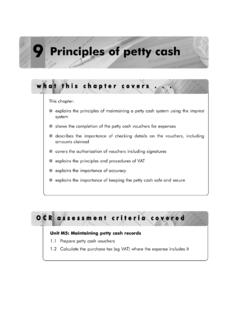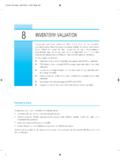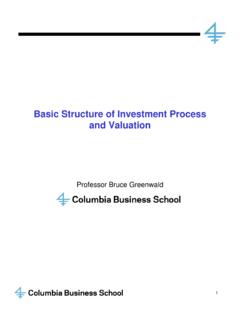Transcription of 3 Published financial statements of limited companies
1 In this chapter we focus on the Published financial statements of limited companies andlook at:nthe purpose and components of financial statementsnthe format of Published financial statementsndealing with dividends in the financial statementsninterpretation of the auditors reportnthe accounting policies followed by a particular companynbonus issues and rights issues of sharesTowards the end of the chapter (page 78) we see how a trial balance for a company isconverted into the layout of Published financial financialstatements of limitedcompanies3this chapter Published financial statements of limited companies 61 INTRODUCTIONAll limited companies have shareholders.
2 Each shareholder owns a part ofthe company and, although they do not take part in the day-to-day running ofthe company (unless they are also directors), they are entitled to know thefinancial results of the limited company, whether public or private, is required by law toproduce financial statements , which are also available for anyone to inspectif they so wish. We need to distinguish between the statutory accountsandthe annual report and accounts. The statutory accountsare required to beproduced under company law, and a copy is filed with the Registrar ofCompanies where it is available for public inspection. The annualreport and accounts often referred to as the corporate report is available to every shareholder and contains:nstatement of profit or loss and other comprehensive incomenstatement of financial positionnstatement of cash flowsnstatement of changes in equitynnotes to the financial statements , including a statement of the company saccounting policiesndirectors reportnauditors report DUTIes aND ResPONsIBILITIes OF DIReCTORsThe directors of a limited company are elected by the shareholders tomanage the company on their behalf.
3 The directors are put in a position oftrust by the shareholders to be responsible for the stewardship of thecompany s financial directors of a limited company have a duty to ensure that the provisionsof the companies Acts which relate to accounting records and statements arefollowed. The main provisions of the Acts are that:na company s accounting records must: show and explain the company s transactions disclose with reasonable accuracy at any time the financial position ofthe company enable the directors to ensure that the company s statements of profitor loss and other comprehensive income and financial position give atrue and fair view of the company s financial positionn a company s accounting records must contain.
4 Day-to-day entries of money received and paid, together with detailsof the transactions a record of the company s assets and liabilities details of inventories held at the end of the yearn a company s financial statements must be prepared in accordance withthe companies Act and with either UK accounting standards orinternational financial reporting standards (note that, in this book, we willstudy only financial statements which comply with IFRSs)n the directors must report annually to the shareholders on the way theyhave run the company on behalf of the shareholdersEvery company director has a responsibility to ensure that the statutoryaccounts are produced and filed with the Registrar of companies within a settime.
5 The filing deadlines after the end of the accounting period are:nnine months for a private limited companynsix months for a public limited companyThere are penalties (fines) for late filing and, if the financial statements aretoo late, a company can be struck off the companies annual financial statements must be approved by the company s boardof directors and the copy of the statement of financial position filed with theRegistrar of companies must be signed by one of the directors on behalf ofthe board. The directors must prepare a directors report this must beapproved by the board and the copy to be filed with the Registrar ofCompanies signed on behalf of the board by a director (or the companysecretary).
6 The statutory accounts must be laid before the company at theannual general meeting, and they must be circulated beforehand toshareholders, debenture holders and any other persons entitled to attend 1 PReseNTaTION OF financial sTaTeMeNTsThe objective of this accounting standard is to set out how financialstatements should be presented to ensure comparability with previousaccounting periods and with other entities. The standard states that theobjective of financial statements is to provide information about the62financial statements of limited companies tutorialpublished financial statements of limited companies 63financial position, financial performance and cash flows of an entity thatis useful to a wide range of users in making economic decisions.
7 Note that this definition is very similar to that stated in the ConceptualFramework for financial Reporting see the definition given on page 7 ofthis statements also show the results of management s stewardship ofthe resources entrusted to it. The statements provide information about anentity s:nassetsnliabilitiesnequitynincome and expenses, including gains and lossesncontributions by, and distributions to, owners in their capacity as ownersncash flowsSuch information along with other information in the notes assists usersof financial statements in assessing the entity s future cash set of financial statementsIAS 1 states that a complete set of financial statements comprises.
8 Nstatement of financial positionnstatement of profit or loss and other comprehensive incomenstatement of changes in equitynstatement of cash flowsnaccounting policies and explanatory notesncomparative information for the preceding periodNote that IAS 1 states that:nall of the financial statements are to be given equal prominencenthe statement of profit or loss and other comprehensive income can bepresented either as a single statement or as a profit or loss section, immediately followed by a separatestatement of comprehensive incomeoverall considerationsThe financial statements must present fairly the financial position, financialperformance, and cash flows of an entity.
9 The application of internationalfinancial reporting standards supported by appropriate additional64financial statements of limited companies tutorialdisclosures is presumed to result in financial statements that achieve a fairpresentation. IAS 1 requires that an entity whose financial statementscomply with the standards should make an explicit and unreserved statementof such compliance in the notes. IAS 1 requires compliance with a number of accounting concepts (see alsopages 20-21) and other considerations:ngoing concern when an entity s financial statements are prepared inaccordance with international financial reporting standards, thepresumption is that the entity is a going concern, ie it will not cease totrade in the immediate futurenaccrual basis of accounting financial statements , except for cash flowinformation, are prepared under the accruals concept, ie income andexpenses are matched to the same accounting periodnmateriality and aggregation each material class of similar items is tobe presented separately in the financial statements .
10 Eg the classificationof assets as non-current and currentnoffsetting generally it is not permitted to set off assets and liabilities,or income and expenses against each other in order to show a net figure,eg cash at bank is not netted off against a bank overdraftnfrequency of reporting financial statements are prepared at leastannually; however, when the reporting period changes, the financialstatements will be for a period longer or shorter than one year and theentity must give the reason for the change and disclose that the amountsin the financial statements are not entirely comparable with those ofprevious periodsncomparative information a requirement to show the figures fromprevious periods for all amounts shown in the financial statements inorder to help users of the statementsstructure and content general principlesIAS 1 sets out the detailed disclosures to be shown on the face of thestatement of profit or loss and other comprehensive income, statement offinancial position.












